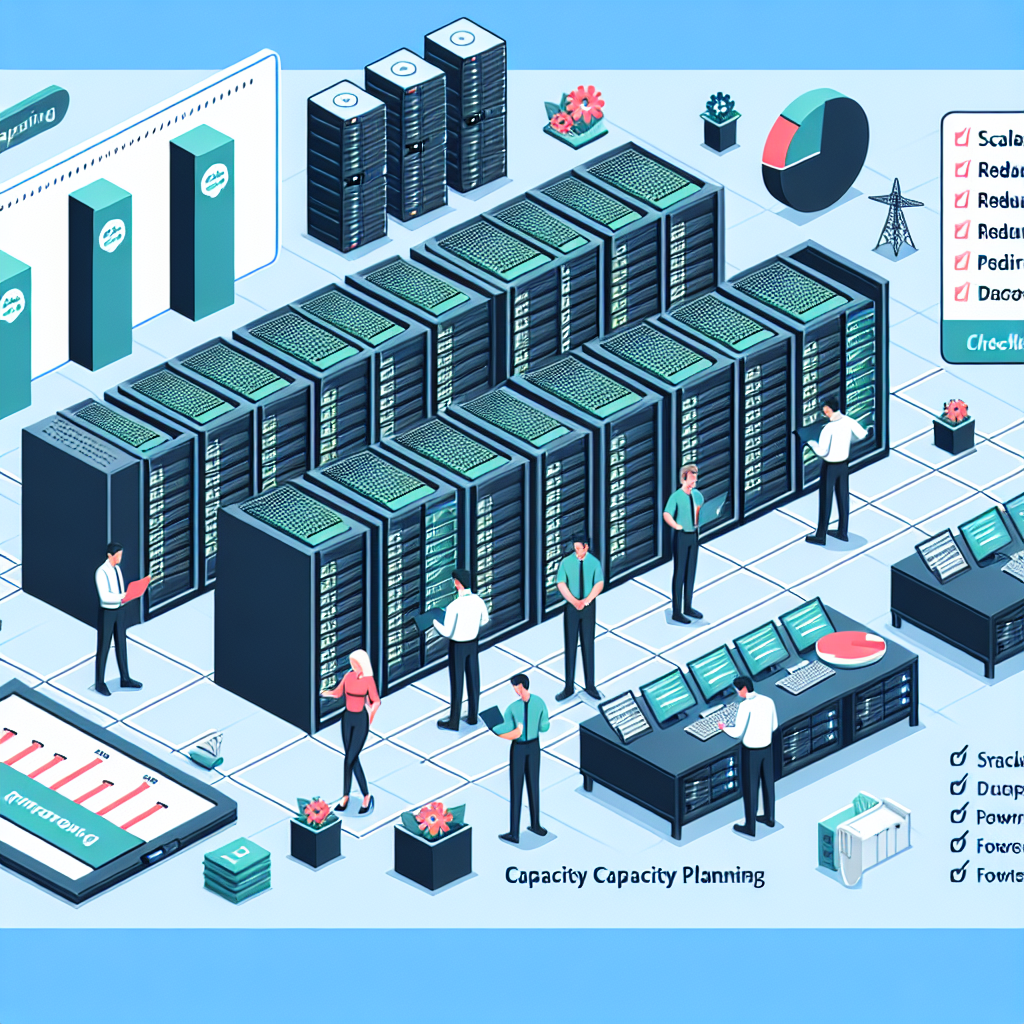Your cart is currently empty!
Tag: Data Center Capacity Planning

How to Optimize Data Center Capacity Planning for Business Growth
Data centers are the backbone of modern businesses, providing the computing power and storage needed to support their operations. As businesses continue to grow and expand, it is crucial to optimize data center capacity planning to ensure that the infrastructure can support the increasing demands.Capacity planning is the process of determining the amount of computing resources and storage needed to meet the current and future needs of a business. By optimizing data center capacity planning, businesses can ensure that they have the right amount of infrastructure in place to support growth without overspending on unnecessary resources.
Here are some tips on how to optimize data center capacity planning for business growth:
1. Conduct a thorough assessment of current infrastructure: Before planning for future growth, it is important to have a clear understanding of the current state of your data center infrastructure. This includes assessing the capacity of servers, storage, networking equipment, and cooling systems. By identifying any bottlenecks or inefficiencies in the current infrastructure, businesses can make informed decisions on how to optimize capacity planning.
2. Forecast future growth: To effectively plan for future capacity needs, businesses must forecast their growth over the next few years. This includes predicting increases in data volume, user traffic, and application demands. By understanding the expected growth rate, businesses can plan for the necessary upgrades and expansions in their data center infrastructure.
3. Utilize virtualization and consolidation: Virtualization technology allows businesses to maximize the use of their existing hardware by running multiple virtual servers on a single physical server. By consolidating servers and storage, businesses can reduce their hardware footprint, energy consumption, and cooling costs. This can help optimize data center capacity planning by making more efficient use of existing resources.
4. Implement monitoring and management tools: To effectively manage data center capacity, businesses should implement monitoring and management tools that provide real-time insights into the performance of their infrastructure. These tools can help businesses identify potential bottlenecks, optimize resource allocation, and make informed decisions on capacity planning.
5. Consider cloud services: In some cases, businesses may find it more cost-effective to leverage cloud services for their computing and storage needs. Cloud services can provide scalability, flexibility, and cost savings, allowing businesses to quickly scale their infrastructure to meet growing demands. By incorporating cloud services into their capacity planning strategy, businesses can optimize their data center capacity and support business growth.
In conclusion, optimizing data center capacity planning is essential for businesses looking to support their growth and expansion. By conducting a thorough assessment of current infrastructure, forecasting future growth, utilizing virtualization and consolidation, implementing monitoring tools, and considering cloud services, businesses can effectively plan for their capacity needs and ensure that their data center infrastructure can support their business goals.

How Data Center Capacity Planning Can Drive Growth and Innovation
In today’s digital age, data centers play a crucial role in enabling businesses to store, manage, and access vast amounts of information. With the increasing reliance on cloud computing, big data analytics, and other data-intensive technologies, the demand for data center capacity has never been greater. However, simply adding more servers and storage devices is not enough to keep up with the growing needs of businesses. Effective capacity planning is essential to ensure that data centers are able to support current and future requirements for performance, scalability, and reliability.Capacity planning involves carefully analyzing and forecasting the resources needed to meet the demands placed on a data center. This includes calculating the amount of computing power, storage capacity, network bandwidth, and cooling infrastructure required to support the workload of applications and services. By accurately predicting future growth and usage patterns, organizations can optimize their investments in data center infrastructure, minimize downtime, and improve overall efficiency.
One of the key benefits of capacity planning is its ability to drive growth and innovation within an organization. By ensuring that data centers are equipped to handle increasing workloads and traffic, businesses can scale their operations more effectively and support new initiatives without being hindered by infrastructure limitations. This allows companies to launch new products and services, enter new markets, and respond to changing customer needs more quickly and efficiently.
Furthermore, capacity planning can help businesses to identify opportunities for innovation and optimization within their data center environments. By analyzing usage patterns and performance metrics, organizations can identify areas where resources are being underutilized or where bottlenecks are occurring. This insight can lead to the implementation of more efficient technologies and processes, such as virtualization, automation, and energy-efficient cooling systems, which can help to reduce costs, improve performance, and enhance overall sustainability.
In addition, capacity planning can also help businesses to improve their disaster recovery and business continuity strategies. By accurately assessing the resources needed to maintain critical operations in the event of a disruption, organizations can ensure that they have the necessary redundancies and failover mechanisms in place to minimize downtime and protect sensitive data. This can help to build trust with customers, partners, and regulators, and safeguard the reputation and long-term viability of the business.
In conclusion, data center capacity planning is a critical component of any organization’s IT strategy. By accurately forecasting and managing resources, businesses can drive growth and innovation, improve operational efficiency, enhance disaster recovery capabilities, and ultimately achieve a competitive advantage in today’s fast-paced digital economy. Investing in capacity planning is not only a smart business decision, but a necessary one for organizations looking to thrive in a data-driven world.

Best Practices for Successful Data Center Capacity Planning
Data center capacity planning is a crucial aspect of managing a data center efficiently and effectively. It involves determining the optimal amount of IT infrastructure resources necessary to support current and future data center operations. By effectively planning for capacity needs, data center managers can ensure that resources are utilized efficiently, costs are minimized, and performance is optimized.Here are some best practices for successful data center capacity planning:
1. Understand your current and future needs: The first step in capacity planning is to understand your current IT infrastructure and data center requirements. This includes assessing the current usage of resources such as server capacity, storage capacity, and network bandwidth. Additionally, it is important to forecast future needs based on business growth, application requirements, and technology trends.
2. Establish performance metrics: Define key performance indicators (KPIs) that will help you measure the performance of your data center infrastructure. This can include metrics such as server utilization rates, storage capacity utilization, network bandwidth utilization, and response times. By monitoring these metrics regularly, you can identify potential bottlenecks and areas for improvement.
3. Conduct regular capacity assessments: Regularly assess the capacity of your data center infrastructure to identify potential risks and opportunities for optimization. This can involve conducting capacity planning exercises on a quarterly or annual basis, as well as monitoring performance metrics in real-time to identify any immediate capacity issues.
4. Utilize forecasting tools: Use forecasting tools and techniques to predict future capacity needs based on historical data, business trends, and growth projections. This can help you anticipate future resource requirements and plan for scalability accordingly.
5. Implement a scalable infrastructure: Design your data center infrastructure to be scalable and flexible, so that it can easily accommodate changes in capacity requirements. This can involve using virtualization technologies, cloud services, and modular hardware components that can be easily added or removed as needed.
6. Consider energy efficiency: In addition to capacity planning, consider energy efficiency measures that can help reduce operating costs and environmental impact. This can include utilizing energy-efficient hardware, optimizing cooling systems, and implementing power management strategies.
7. Develop a capacity management plan: Develop a comprehensive capacity management plan that outlines roles, responsibilities, processes, and tools for managing data center capacity. This plan should include guidelines for capacity monitoring, forecasting, allocation, and optimization.
By following these best practices for data center capacity planning, organizations can ensure that their data center infrastructure is optimized for performance, efficiency, and scalability. By effectively managing capacity needs, data center managers can minimize risks, reduce costs, and support the growth of their organizations.

The Benefits of Data Center Capacity Planning for Cost Savings and Resource Optimization
Data centers are the backbone of modern business operations, providing the necessary infrastructure for storing, processing, and managing large amounts of data. As companies continue to expand their digital footprint, the demand for data center capacity planning has become increasingly important. By effectively planning and optimizing data center capacity, businesses can achieve significant cost savings and resource optimization.One of the key benefits of data center capacity planning is cost savings. By accurately forecasting future capacity needs, businesses can avoid overprovisioning their data center resources, which can lead to unnecessary expenses. Overprovisioning often occurs when companies allocate more resources than necessary to meet current or future demands, resulting in wasted resources and increased operational costs. By conducting regular capacity planning assessments, businesses can identify and eliminate inefficiencies in their data center operations, leading to cost savings over time.
In addition to cost savings, data center capacity planning also helps businesses optimize resource utilization. By analyzing historical data and future projections, companies can identify underutilized resources and reallocate them to areas of higher demand. This ensures that resources are being used efficiently and effectively, maximizing the value of the data center investment. By optimizing resource utilization, businesses can improve overall performance, reduce downtime, and enhance the user experience for customers and employees.
Furthermore, data center capacity planning enables businesses to better prepare for future growth and scalability. By understanding current capacity constraints and forecasting future demands, companies can proactively plan for expansion and upgrade their data center infrastructure as needed. This ensures that the data center can support the organization’s growth objectives and strategic initiatives without experiencing performance bottlenecks or downtime. By planning for scalability, businesses can avoid costly last-minute upgrades and disruptions to operations.
Overall, data center capacity planning is essential for achieving cost savings and resource optimization in today’s digital-driven business environment. By accurately forecasting capacity needs, optimizing resource utilization, and planning for scalability, companies can improve operational efficiency, reduce costs, and enhance the overall performance of their data center infrastructure. Investing in data center capacity planning is a strategic decision that can deliver long-term benefits and competitive advantages for businesses of all sizes.

Key Considerations for Data Center Capacity Planning in a Hybrid Cloud Environment
Data centers play a crucial role in the modern digital landscape, serving as the backbone of businesses’ IT infrastructure. As organizations increasingly adopt hybrid cloud environments to meet their computing needs, ensuring proper capacity planning becomes even more critical. This article will discuss key considerations for data center capacity planning in a hybrid cloud environment.1. Scalability: One of the primary advantages of a hybrid cloud environment is its scalability. When planning data center capacity, it’s essential to consider the ability to scale up or down based on fluctuating workloads. By leveraging cloud resources, organizations can easily expand their capacity during peak times and reduce it during off-peak periods, ensuring optimal performance and cost-efficiency.
2. Workload distribution: In a hybrid cloud environment, workloads can be distributed across on-premises data centers and public cloud infrastructure. When planning capacity, organizations must carefully assess the performance requirements of each workload and determine the best placement to achieve optimal performance and cost-effectiveness. By strategically distributing workloads, organizations can maximize resource utilization and ensure seamless operation.
3. Data security and compliance: Data security and compliance are top priorities for organizations operating in a hybrid cloud environment. When planning data center capacity, it’s crucial to consider the security and compliance requirements of sensitive data and applications. Organizations must implement robust security measures, such as encryption, access controls, and monitoring, to protect their data and comply with industry regulations.
4. Cost optimization: Cost optimization is a key consideration in data center capacity planning. By leveraging hybrid cloud resources, organizations can achieve cost savings by dynamically scaling their capacity based on demand and utilizing cost-effective cloud services. When planning capacity, organizations must carefully assess their budget constraints and identify opportunities to optimize costs without compromising performance or security.
5. Performance monitoring and management: Monitoring and managing performance are essential aspects of data center capacity planning in a hybrid cloud environment. Organizations must implement robust monitoring tools to track resource usage, identify bottlenecks, and optimize performance. By continuously monitoring performance metrics, organizations can proactively adjust capacity to meet changing demand and ensure optimal performance.
In conclusion, data center capacity planning is a critical aspect of managing IT infrastructure in a hybrid cloud environment. By considering scalability, workload distribution, data security, cost optimization, and performance monitoring, organizations can effectively plan and manage their capacity to meet their computing needs while maximizing efficiency and cost-effectiveness. By carefully assessing these key considerations, organizations can ensure a seamless and successful transition to a hybrid cloud environment.

Navigating the Challenges of Data Center Capacity Planning in a Growing Organization
In today’s digital age, data has become the lifeblood of organizations. With the increasing reliance on data for decision-making and operations, the demand for data center capacity has been on the rise. However, navigating the challenges of data center capacity planning in a growing organization can be a daunting task.One of the main challenges faced by organizations is the rapid growth of data. As businesses collect more data from various sources, the need for additional storage and processing power increases. This can put a strain on existing data center infrastructure, leading to performance issues and downtime.
Another challenge is predicting future capacity needs. With the pace of technological advancements and business growth, it can be difficult to accurately forecast how much capacity will be required in the future. This can result in either underutilized resources or inadequate capacity, both of which can impact the organization’s bottom line.
To overcome these challenges, organizations need to adopt a proactive approach to data center capacity planning. This involves regularly assessing current capacity utilization, monitoring trends in data growth, and forecasting future capacity needs. By taking a data-driven approach to capacity planning, organizations can better align their infrastructure with business requirements and avoid costly downtime.
In addition, organizations should consider implementing scalable and flexible infrastructure solutions. Cloud computing, for example, allows organizations to quickly scale up or down based on demand, providing a cost-effective and efficient way to manage capacity. Virtualization technologies can also help optimize resource utilization and improve overall data center efficiency.
Furthermore, organizations should prioritize regular maintenance and upgrades to ensure that their data center infrastructure remains reliable and secure. This includes monitoring equipment health, conducting regular audits, and implementing best practices for data center management.
In conclusion, navigating the challenges of data center capacity planning in a growing organization requires a strategic and proactive approach. By staying ahead of data growth trends, adopting scalable infrastructure solutions, and prioritizing maintenance and upgrades, organizations can ensure that their data center can support their evolving business needs. With careful planning and investment, organizations can effectively manage their data center capacity and drive business growth.

Maximizing Efficiency: Tips for Effective Data Center Capacity Planning
In today’s fast-paced digital world, data centers play a crucial role in storing, managing, and processing vast amounts of information. As businesses continue to rely on data centers for their operations, it becomes essential to maximize efficiency in capacity planning to ensure optimal performance and cost-effectiveness. Here are some tips for effective data center capacity planning:1. Conduct regular capacity assessments: It is essential to regularly assess the capacity of your data center to identify any potential bottlenecks or areas for improvement. By understanding the current usage and future growth projections, you can make informed decisions about expanding or optimizing your infrastructure.
2. Implement monitoring and reporting tools: Utilize monitoring and reporting tools to track key performance metrics such as power consumption, cooling efficiency, and server utilization. By analyzing this data, you can identify areas of inefficiency and take proactive measures to optimize your data center’s capacity.
3. Utilize virtualization technologies: Virtualization technologies allow you to maximize the utilization of your servers by running multiple virtual machines on a single physical server. This helps reduce hardware costs, improve resource allocation, and increase overall efficiency in your data center.
4. Consider modular or containerized solutions: Modular or containerized data center solutions offer a scalable and flexible approach to capacity planning. By deploying pre-fabricated modules or containers, you can quickly expand your data center capacity to meet growing demands without the need for extensive construction or downtime.
5. Optimize cooling and power distribution: Cooling and power distribution are critical components of data center capacity planning. By implementing energy-efficient cooling systems and optimizing power distribution, you can reduce operational costs and improve the overall efficiency of your data center.
6. Embrace cloud computing: Cloud computing offers a cost-effective and scalable solution for data storage and processing. By leveraging cloud services, you can offload some of the capacity requirements from your on-premises data center, allowing you to focus on optimizing your core infrastructure for maximum efficiency.
7. Collaborate with vendors and partners: Work closely with your hardware and software vendors, as well as data center service providers, to leverage their expertise and resources in capacity planning. By building strong partnerships, you can access cutting-edge technologies and best practices to optimize your data center capacity.
In conclusion, maximizing efficiency in data center capacity planning is essential for ensuring the performance, scalability, and cost-effectiveness of your infrastructure. By following these tips and implementing best practices, you can optimize your data center capacity to meet the evolving needs of your business and customers.

How to Successfully Implement Data Center Capacity Planning Strategies
Data center capacity planning is a crucial aspect of managing a data center efficiently and effectively. By implementing a sound data center capacity planning strategy, organizations can ensure that their data centers are able to meet the demands of their users and applications, while also maximizing resource utilization and minimizing costs. In this article, we will discuss some key strategies for successfully implementing data center capacity planning.1. Define Your Goals and Objectives:
The first step in implementing a successful data center capacity planning strategy is to clearly define your goals and objectives. This includes understanding the current and future needs of your organization, as well as any specific requirements or constraints that may need to be taken into account. By having a clear understanding of what you are trying to achieve, you can develop a more targeted and effective capacity planning strategy.
2. Conduct a Comprehensive Assessment:
Before implementing any capacity planning strategy, it is important to conduct a comprehensive assessment of your current data center environment. This includes evaluating the current utilization of resources, identifying any bottlenecks or performance issues, and understanding the growth trends of your organization. By having a thorough understanding of your existing infrastructure, you can better plan for future capacity needs.
3. Utilize Monitoring and Reporting Tools:
Monitoring and reporting tools are essential for effective data center capacity planning. These tools can provide real-time insights into the performance and utilization of your data center resources, allowing you to identify potential issues and make informed decisions about capacity planning. By utilizing these tools, you can proactively manage your data center capacity and ensure that your resources are being utilized efficiently.
4. Implement Scalable Solutions:
When planning for data center capacity, it is important to implement scalable solutions that can easily accommodate growth and changes in demand. This includes investing in technologies that can easily scale up or down based on your organization’s needs, such as virtualization and cloud computing. By implementing scalable solutions, you can ensure that your data center can adapt to changing requirements without incurring unnecessary costs.
5. Continuously Monitor and Adjust:
Data center capacity planning is an ongoing process that requires continuous monitoring and adjustment. It is important to regularly review and analyze the performance and utilization of your data center resources, and make adjustments as needed to ensure optimal performance and efficiency. By continuously monitoring and adjusting your capacity planning strategy, you can ensure that your data center is able to meet the demands of your organization effectively.
In conclusion, implementing a successful data center capacity planning strategy is essential for managing a data center efficiently and effectively. By defining clear goals and objectives, conducting a comprehensive assessment, utilizing monitoring and reporting tools, implementing scalable solutions, and continuously monitoring and adjusting your capacity planning strategy, organizations can ensure that their data centers are able to meet the demands of their users and applications while maximizing resource utilization and minimizing costs.

Maximizing Efficiency through Data Center Capacity Planning
Data centers are the backbone of modern businesses, responsible for storing and managing vast amounts of data critical to their daily operations. As the demand for data storage and processing continues to grow, it is essential for organizations to maximize efficiency through effective capacity planning.Capacity planning is the process of determining the optimal amount of resources needed to support current and future demands in a data center. By analyzing historical data, predicting future growth, and identifying potential bottlenecks, organizations can ensure that their data center infrastructure is able to meet the needs of their business.
One of the key benefits of capacity planning is the ability to optimize resource utilization. By accurately forecasting demand and allocating resources accordingly, organizations can prevent overprovisioning, which can lead to wasted resources and increased costs. Conversely, underprovisioning can result in performance issues and downtime, impacting the overall productivity of the organization.
In addition to resource optimization, capacity planning can also help organizations identify and address potential vulnerabilities in their data center infrastructure. By conducting regular capacity assessments and performance monitoring, organizations can proactively identify and rectify any issues before they impact the business.
To maximize efficiency through data center capacity planning, organizations should consider the following best practices:
1. Conduct regular capacity assessments: Regularly reviewing and analyzing data center performance metrics can help organizations identify trends and patterns that may indicate future resource requirements.
2. Predict future growth: By analyzing historical data and predicting future growth trends, organizations can ensure that their data center infrastructure can scale to meet the needs of the business.
3. Implement automation: Automating capacity planning processes can help organizations streamline operations and reduce the risk of human error.
4. Consider cloud options: Cloud computing offers organizations the flexibility to scale resources up or down as needed, helping to optimize resource utilization and reduce costs.
5. Collaborate with stakeholders: Involving key stakeholders in the capacity planning process can help ensure that all aspects of the business are taken into account, leading to more accurate forecasting and resource allocation.
In conclusion, maximizing efficiency through data center capacity planning is essential for organizations looking to optimize resource utilization, prevent downtime, and ensure the scalability of their infrastructure. By following best practices and leveraging technology solutions, organizations can effectively plan for future growth and meet the demands of their business in a cost-effective manner.

